|
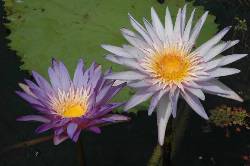
Tubering Tropical Waterlilies
In Warm Climates
by Kit Knotts - Click images to enlarge
For those of us with really warm climates and long seasons,
getting tropical waterlilies to tuber can be very difficult.
Too often, plants overgrow and develop large rhizomes that rarely
produce new plants. In order to replicate desirable plants, we
have had to develop methods different from those possible in
colder areas.
It's really important to say at the outset that these methods
only work for small plants that have NOT developed a growth rhizome.
A few varieties will make new plants from big rhizomes but most
won't. Some people have success turning pots over under benches
and others simply throw plants on the ground to promote tuber
formation. We can't do that as they are candy for a variety of
critters, especially rats. We have to float them.
The earliest that we recommend floating a plant for tuber
is when it has several healthy floating leaves. If you are evaluating
a new plant and want to bloom it before tubering, allow only
a few flowers to open before committing to floating it. It's
far better to have a small plant and a tuber than a single large
plant that won't tuber!
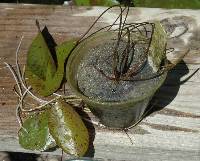
|

|
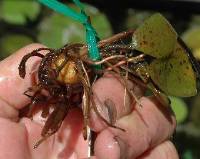
|
|
Remove the plant from the pot, wash away the soil, trim roots
to deprive it of nutrients, tag it and float it. After some experimenting,
we feel tubers form faster in full sun and very warm water than
in shaded cooler water. In a few weeks, you will have a little
tuber forming under the crown. |
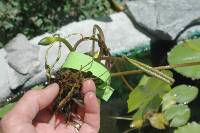
|
Plants that have reached blooming size can take more time to
produce a tuber and the tuber is likely to be larger. Remove
larger leaves a few at a time and continue to trim off developing
roots. With any size plant you are trying to tuber, it is important
to shut the plant down far enough that it will be possible to
remove the plant without damaging the tuber. In some cases, this
may have to be all the way to small underwater leaves. |
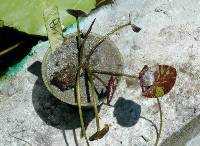
|
Plant the tuber on its side or even at a downward angle. Be sure
not to bury the rosette leaves. The tuber need not be buried
in the soil. When the plant has several floating leaves and has
developed roots independent of the tuber, you can consider trying
to remove the tuber. Sometimes it will twist off rather easily.
Other times it will be necessary to remove it with a knife as
below |
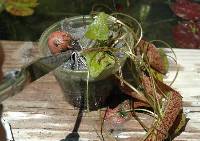
|
You can either remove the plant(s) and tuber from the soil or,
if you can see well enough, leave the plants in the soil. With
the tip of a knife, gently pry the plants from the tuber. THIS
CAN BE VERY TRICKY SO BE CAREFUL! |
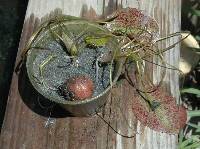
|
|
In the process of this illustration, I severed two smaller plants
above their tiny crowns killing them, though two larger plants
came away from the tuber intact. Another still attached to the
tuber may survive. |
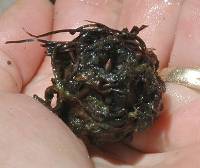
|
At this point the tuber can be stored or restarted.
< A tuber from which two plants were removed with a knife
tip. A tiny new plant can be seen forming right in the center
after about a week in very warm water.
A tuber gone mad! This was restarted about two
weeks prior to the photo. > |
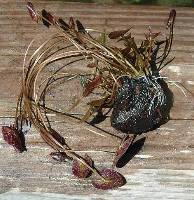 |
|
The dog ate my homework but
I got it back. |
|
Not long ago, I thought I had pried too deeply into a tuber removing
a plant and decided to dust the wound with antifungal powder.
Our dog Cheech was extremely interested in the smell of the powder
but wandered away. I thought I would allow the tuber and powder
to dry briefly on the edge of a propagation pond, turned away,
and heard a loud crunch. Cheech was eating the tuber! I grabbed
his mouth and extracted the tuber, but not before he had cracked
it in half. Even though I was sure it would rot before it had
a chance to reproduce, I put it in warm water to give it a chance.
This tiny plant is trying hard to prove me wrong! > |

|
Growing Tropicals From Tuber by Kit Knotts
Tropical Waterlily Tuber Propagation by Sean Stevens
Tuber
Production of Tropical Waterlilies by Walter Pagels
Repotting
Overgrown Tropical Waterlilies by Kit Knotts
|










